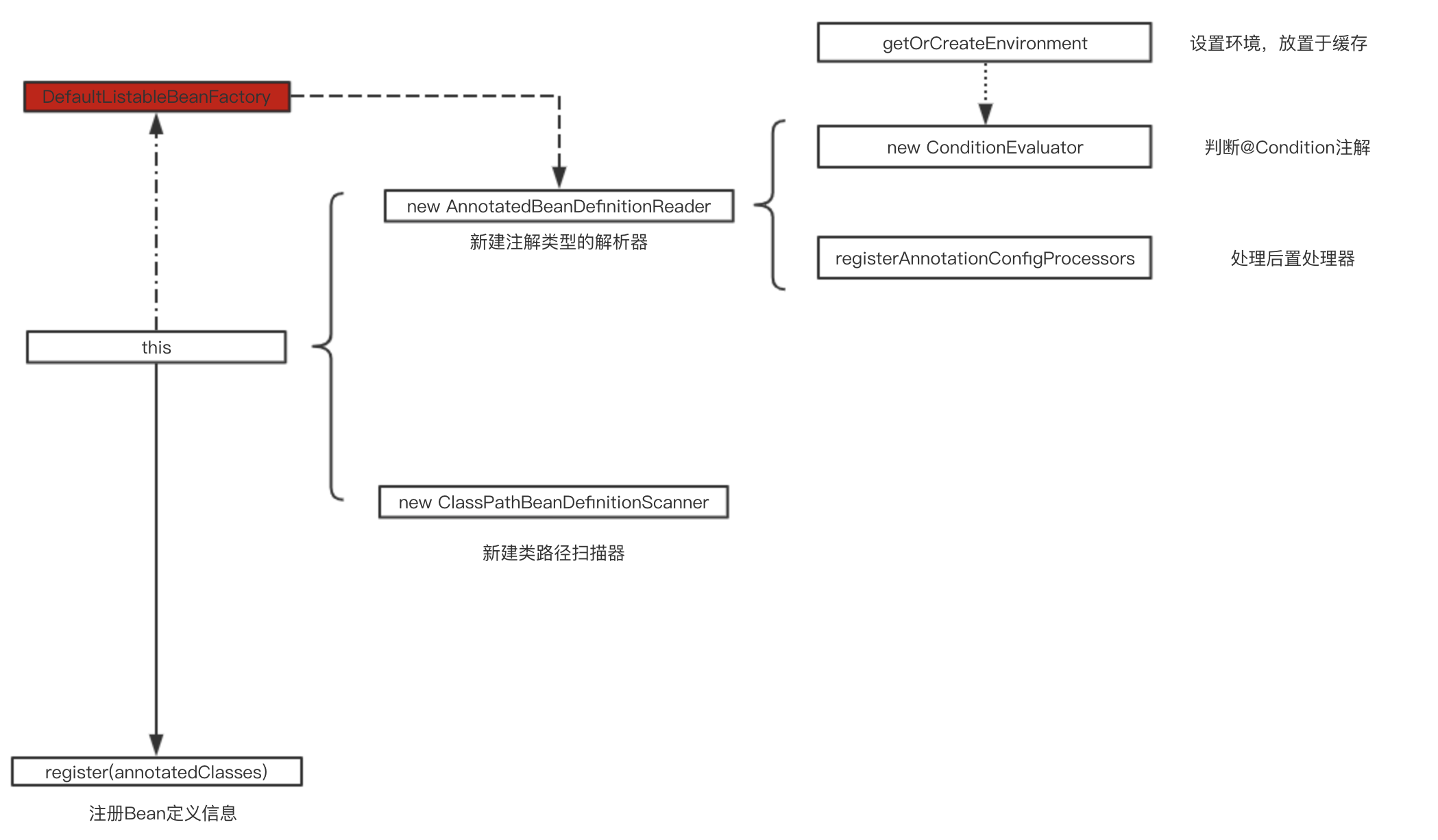我们这次来叭叭一下Spring的源码,这次博客主要来说说Spring源码,先粗略的撸一遍,下篇博客选几个重点去说,由于过于复杂,我也是看了一点点,我们先来过一遍源码,然后上流程图,最后我们再回头总结一下,我们来循序渐进的叭叭一下。
我们来回顾一下上次Spring博客的内容,每次都有用到AnnotationConfigApplicationContext来加载我们的配置类,我们就从这里开始。
/** * Create a new AnnotationConfigApplicationContext, deriving bean definitions * from the given annotated classes and automatically refreshing the context. 创建新的注释configapplicationcontext,获得bean定义并自动刷新上下文。 * @param annotatedClasses one or more annotated classes, 我们的配置类 * e.g. {@link Configuration @Configuration} classes */ public AnnotationConfigApplicationContext(Class<?>... annotatedClasses) { this(); register(annotatedClasses); refresh(); }
翻译过来就是“创建新的注释configapplicationcontext,获得bean定义并自动刷新上下文”。三个方法,我们先来一个个看,优先看父类有没有构造方法。AnnotationConfigApplicationContext继承了GenericApplicationContext类,所以我们先看GenericApplicationContext类的构造方法。代码很简单
父类构造方法
/** * Create a new GenericApplicationContext. * @see #registerBeanDefinition * @see #refresh */ public GenericApplicationContext() { this.beanFactory = new DefaultListableBeanFactory(); }
这里创建了一个新的DefaultListableBeanFactory对象,也是我们熟悉的beanFactory对象,记住是DefaultListableBeanFactory对象。我们回到AnnotationConfigApplicationContext的this方法。
this
/** * Create a new AnnotationConfigApplicationContext that needs to be populated * through {@link #register} calls and then manually {@linkplain #refresh refreshed}. */ public AnnotationConfigApplicationContext() { this.reader = new AnnotatedBeanDefinitionReader(this);//注解类型的解析器 this.scanner = new ClassPathBeanDefinitionScanner(this);//包扫描器 }
再往下扒一层。看一下那个AnnotatedBeanDefinitionReader注解类型的解析器是怎么创建的,里面都有什么。
/** * Create a new {@code AnnotatedBeanDefinitionReader} for the given registry. * If the registry is {@link EnvironmentCapable}, e.g. is an {@code ApplicationContext}, * the {@link Environment} will be inherited, otherwise a new * {@link StandardEnvironment} will be created and used. * @param registry the {@code BeanFactory} to load bean definitions into, * in the form of a {@code BeanDefinitionRegistry} * @see #AnnotatedBeanDefinitionReader(BeanDefinitionRegistry, Environment) * @see #setEnvironment(Environment) */ public AnnotatedBeanDefinitionReader(BeanDefinitionRegistry registry) { this(registry, getOrCreateEnvironment(registry)); //优先设置了环境并存在缓存内 }
设置了环境,将我们的beanFactory作为参数,做了this调用,
/** * Create a new {@code AnnotatedBeanDefinitionReader} for the given registry and using * the given {@link Environment}. 用registry和Environment创建一个新的AnnnotatedBeanDefinitionReader * @param registry the {@code BeanFactory} to load bean definitions into, * in the form of a {@code BeanDefinitionRegistry} * @param environment the {@code Environment} to use when evaluating bean definition * profiles. * @since 3.1 */ public AnnotatedBeanDefinitionReader(BeanDefinitionRegistry registry, Environment environment) { Assert.notNull(registry, "BeanDefinitionRegistry must not be null"); Assert.notNull(environment, "Environment must not be null"); this.registry = registry; this.conditionEvaluator = new ConditionEvaluator(registry, environment, null); AnnotationConfigUtils.registerAnnotationConfigProcessors(this.registry); }
前三行不用看,第四行是用来解析我们@Conditional注解的。可以自己打开瞧瞧源代码。我们直接看第五行AnnotationConfigUtils.registerAnnotationConfigProcessors(this.registry); 也是很重要的代码,我们继续叭叭。
/** * Register all relevant annotation post processors in the given registry. * @param registry the registry to operate on * @param source the configuration source element (already extracted) * that this registration was triggered from. May be {@code null}. * @return a Set of BeanDefinitionHolders, containing all bean definitions * that have actually been registered by this call */ public static Set<BeanDefinitionHolder> registerAnnotationConfigProcessors( BeanDefinitionRegistry registry, @Nullable Object source) { DefaultListableBeanFactory beanFactory = unwrapDefaultListableBeanFactory(registry); if (beanFactory != null) { if (!(beanFactory.getDependencyComparator() instanceof AnnotationAwareOrderComparator)) { beanFactory.setDependencyComparator(AnnotationAwareOrderComparator.INSTANCE); } if (!(beanFactory.getAutowireCandidateResolver() instanceof ContextAnnotationAutowireCandidateResolver)) { beanFactory.setAutowireCandidateResolver(new ContextAnnotationAutowireCandidateResolver()); } } Set<BeanDefinitionHolder> beanDefs = new LinkedHashSet<>(8); if (!registry.containsBeanDefinition(CONFIGURATION_ANNOTATION_PROCESSOR_BEAN_NAME)) { RootBeanDefinition def = new RootBeanDefinition(ConfigurationClassPostProcessor.class); def.setSource(source); beanDefs.add(registerPostProcessor(registry, def, CONFIGURATION_ANNOTATION_PROCESSOR_BEAN_NAME)); } if (!registry.containsBeanDefinition(AUTOWIRED_ANNOTATION_PROCESSOR_BEAN_NAME)) { RootBeanDefinition def = new RootBeanDefinition(AutowiredAnnotationBeanPostProcessor.class); def.setSource(source); beanDefs.add(registerPostProcessor(registry, def, AUTOWIRED_ANNOTATION_PROCESSOR_BEAN_NAME)); } // Check for JSR-250 support, and if present add the CommonAnnotationBeanPostProcessor. if (jsr250Present && !registry.containsBeanDefinition(COMMON_ANNOTATION_PROCESSOR_BEAN_NAME)) { RootBeanDefinition def = new RootBeanDefinition(CommonAnnotationBeanPostProcessor.class); def.setSource(source); beanDefs.add(registerPostProcessor(registry, def, COMMON_ANNOTATION_PROCESSOR_BEAN_NAME)); } // Check for JPA support, and if present add the PersistenceAnnotationBeanPostProcessor. if (jpaPresent && !registry.containsBeanDefinition(PERSISTENCE_ANNOTATION_PROCESSOR_BEAN_NAME)) { RootBeanDefinition def = new RootBeanDefinition(); try { def.setBeanClass(ClassUtils.forName(PERSISTENCE_ANNOTATION_PROCESSOR_CLASS_NAME, AnnotationConfigUtils.class.getClassLoader())); } catch (ClassNotFoundException ex) { throw new IllegalStateException( "Cannot load optional framework class: " + PERSISTENCE_ANNOTATION_PROCESSOR_CLASS_NAME, ex); } def.setSource(source); beanDefs.add(registerPostProcessor(registry, def, PERSISTENCE_ANNOTATION_PROCESSOR_BEAN_NAME)); } if (!registry.containsBeanDefinition(EVENT_LISTENER_PROCESSOR_BEAN_NAME)) { RootBeanDefinition def = new RootBeanDefinition(EventListenerMethodProcessor.class); def.setSource(source); beanDefs.add(registerPostProcessor(registry, def, EVENT_LISTENER_PROCESSOR_BEAN_NAME)); } if (!registry.containsBeanDefinition(EVENT_LISTENER_FACTORY_BEAN_NAME)) { RootBeanDefinition def = new RootBeanDefinition(DefaultEventListenerFactory.class); def.setSource(source); beanDefs.add(registerPostProcessor(registry, def, EVENT_LISTENER_FACTORY_BEAN_NAME)); } return beanDefs; }
原文的注释为在给定的注册器中处理所有有意义的后置处理器,基本就是是否包含***,如果包含就set进去。这段代码是用来初始化内部的组件的。走到这里就已经初始化的Bean定义。也就是说我们的容器已经注入了定义信息,还未实例化。
this方法的上半部分就说完了,我们再来看下半部分的new ClassPathBeanDefinitionScanner,创建一个类路径扫描器,这个代码不多,就是判断我们是否使用默认的类路径扫描器。
1 /** 2 * Create a new {@code ClassPathBeanDefinitionScanner} for the given bean factory and 3 * using the given {@link Environment} when evaluating bean definition profile metadata. 4 * @param registry the {@code BeanFactory} to load bean definitions into, in the form 5 * of a {@code BeanDefinitionRegistry} 6 * @param useDefaultFilters whether to include the default filters for the 7 * {@link org.springframework.stereotype.Component @Component}, 8 * {@link org.springframework.stereotype.Repository @Repository}, 9 * {@link org.springframework.stereotype.Service @Service}, and 10 * {@link org.springframework.stereotype.Controller @Controller} stereotype annotations 11 * @param environment the Spring {@link Environment} to use when evaluating bean 12 * definition profile metadata 13 * @param resourceLoader the {@link ResourceLoader} to use 14 * @since 4.3.6 15 */ 16 public ClassPathBeanDefinitionScanner(BeanDefinitionRegistry registry, boolean useDefaultFilters, 17 Environment environment, @Nullable ResourceLoader resourceLoader) { 18 19 Assert.notNull(registry, "BeanDefinitionRegistry must not be null"); 20 this.registry = registry; 21 22 if (useDefaultFilters) { 23 registerDefaultFilters(); 24 } 25 setEnvironment(environment); 26 setResourceLoader(resourceLoader); 27 }
我们来直接看一下第23行代码,是否注册一个默认的过滤器(扫描策略)。25行设置环境,26行设置资源加载器。
到这里就已经制定好了我们的扫描策略了。
有点乱啊梳理一下。

register(annotatedClasses)
this部分就说你完了,再来看看register(annotatedClasses);字面意思来看是带着我们的配置文件注册,我们来看一下代码。
/** * Register one or more annotated classes to be processed. * <p>Note that {@link #refresh()} must be called in order for the context * to fully process the new classes. * @param annotatedClasses one or more annotated classes, * e.g. {@link Configuration @Configuration} classes * @see #scan(String...) * @see #refresh() */ public void register(Class<?>... annotatedClasses) { Assert.notEmpty(annotatedClasses, "At least one annotated class must be specified"); this.reader.register(annotatedClasses); }
用我们上一步的reader解析器去注册,里面是一个循环方法。最终调用doRegisterBean来真正的注册。这一步我们先来简单的叫做注册吧。

直到这里其实我们容器还是没有创建的,这些都是一些前期的准备工作。最后也是最关键的一步才是我们的容器的实例化。refresh()方法。内容超多。
@Override public void refresh() throws BeansException, IllegalStateException { synchronized (this.startupShutdownMonitor) { // Prepare this context for refreshing. prepareRefresh(); // Tell the subclass to refresh the internal bean factory. ConfigurableListableBeanFactory beanFactory = obtainFreshBeanFactory(); // Prepare the bean factory for use in this context. prepareBeanFactory(beanFactory); try { // Allows post-processing of the bean factory in context subclasses. postProcessBeanFactory(beanFactory); // Invoke factory processors registered as beans in the context. invokeBeanFactoryPostProcessors(beanFactory); // Register bean processors that intercept bean creation. registerBeanPostProcessors(beanFactory); // Initialize message source for this context. initMessageSource(); // Initialize event multicaster for this context. initApplicationEventMulticaster(); // Initialize other special beans in specific context subclasses. onRefresh(); // Check for listener beans and register them. registerListeners(); // Instantiate all remaining (non-lazy-init) singletons. finishBeanFactoryInitialization(beanFactory); // Last step: publish corresponding event. finishRefresh(); } catch (BeansException ex) { if (logger.isWarnEnabled()) { logger.warn("Exception encountered during context initialization - " + "cancelling refresh attempt: " + ex); } // Destroy already created singletons to avoid dangling resources. destroyBeans(); // Reset 'active' flag. cancelRefresh(ex); // Propagate exception to caller. throw ex; } finally { // Reset common introspection caches in Spring's core, since we // might not ever need metadata for singleton beans anymore... resetCommonCaches(); } } }
我们来逐个方法看一下都是做什么的。
prepareRefresh()创建早期程序监听器。
ConfigurableListableBeanFactory beanFactory = obtainFreshBeanFactory()通知子类刷新Bean工厂
prepareBeanFactory(beanFactory)配置工厂上下文。
postProcessBeanFactory(beanFactory)处理Bean工厂的后置处理
invokeBeanFactoryPostProcessors实例化并调用所有注册的Bean工厂的后置处理器
registerBeanPostProcessors(beanFactory)注册Bean工厂的后置处理器
initMessageSource()初始化消息源
initApplicationEventMulticaster()初始化事件多播器
onRefresh()初始化特殊定义的Bean
registerListeners()注册事件监听器
finishBeanFactoryInitialization(beanFactory)实例化剩余非懒加载Bean
finishRefresh()事件发布
resetCommonCaches()刷新缓存
就这样我们的Bean工厂就创建完成了。看着如此简单吧。后面我们来详细看一下。内部还有超多的东西。Spring源码不建议太过于深入的学习,容易陷进去....


最近搞了一个个人公众号,会每天更新一篇原创博文,java,python,自然语言处理相关的知识有兴趣的小伙伴可以关注一下。
